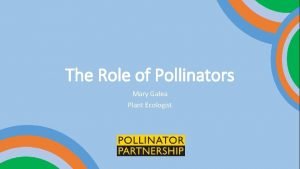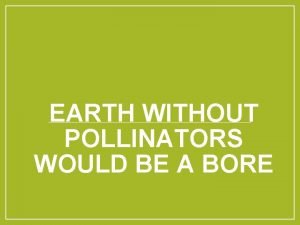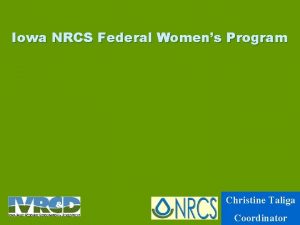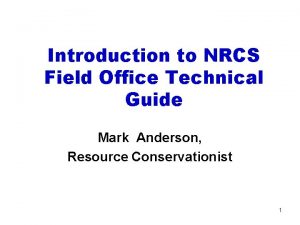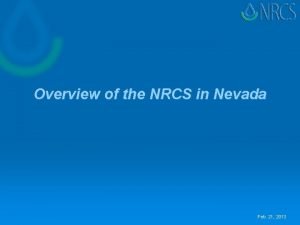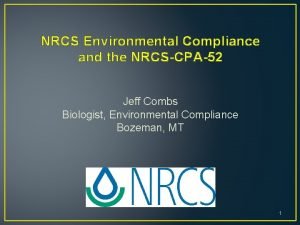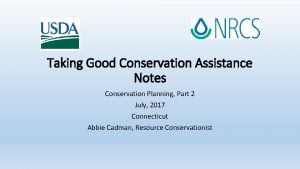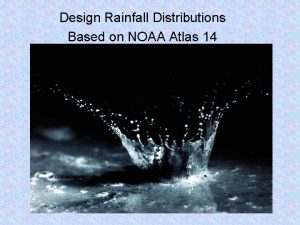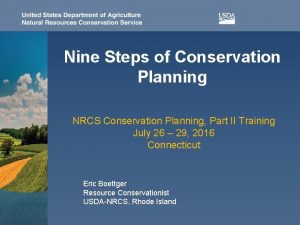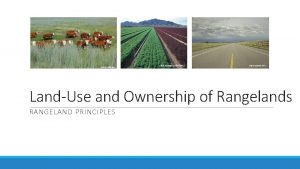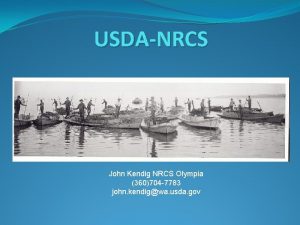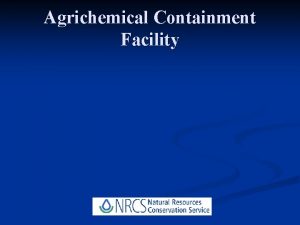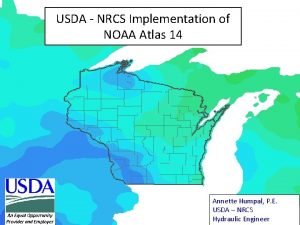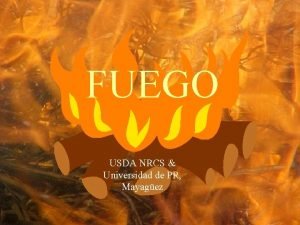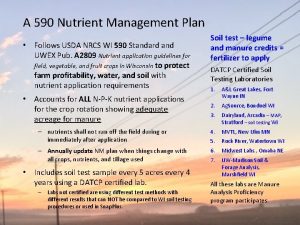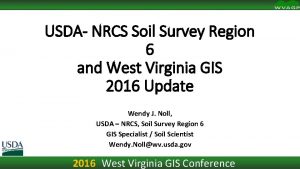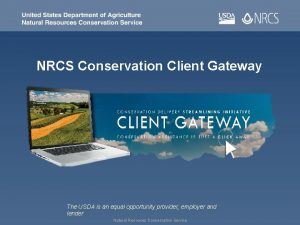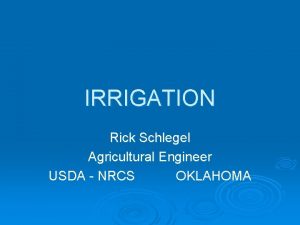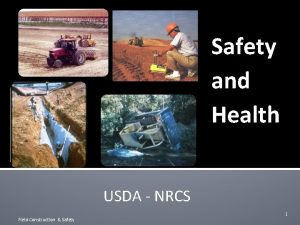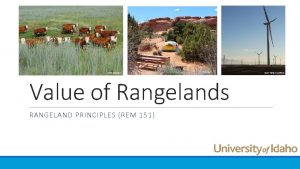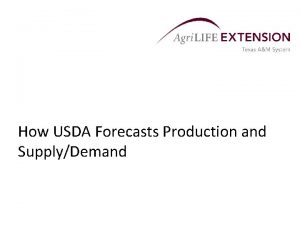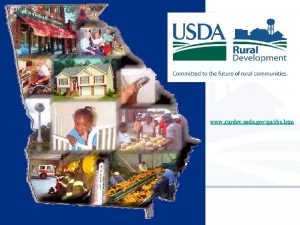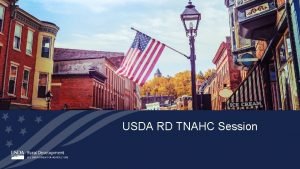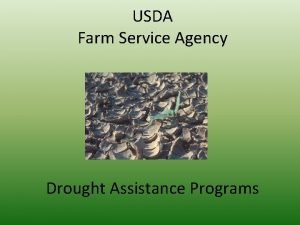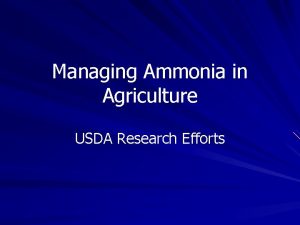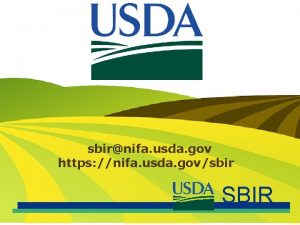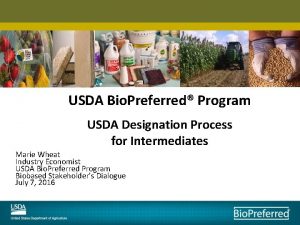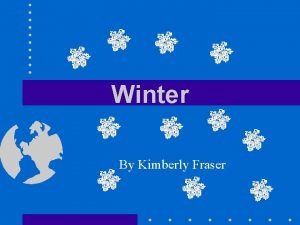USDA NRCS Pollinators PEGGY WINTER USDANRCS Who We

































- Slides: 33

USDA NRCS Pollinators PEGGY WINTER USDA-NRCS

Who We Are. . . The Natural Resources Conservation Service (NRCS) is the federal agency that works with landowners on private lands to conserve natural resources. NRCS was formerly called the Soil Erosion Service “SES” then Soil Conservation Service "SCS“ and finally became NRCS in 1994. Dust storms and gullies ravaged the Nation’s farmland, stripping away millions of topsoil.

Who We Are. . . Since that time, NRCS has not only kept its commitment to protecting and conserving soil but also recognized the need to establish, promote and maintain other natural resources on America’s private lands. Mission – provide leadership in a partnership effort to help people conserve, maintain, and improve our natural resources and environment.

Who We Are. . . We work with customers to help them reduce erosion, protect wildlife, promote good land water use, and preserve the nation’s natural resources.

Objectives: Pollinators • Why are pollinators important? • What role do pollinators play in the survival of plants? • What can you do to promote pollinators?

Why are pollinators important?



Honey Bees in Decline Honey bee colony rental rates for selected California crops, 1995– 2005.

2008 Honey Bees in Decline Honey bee colony rental rates for selected California crops, 1995– 2005. Plus almonds, 2006 -2008 2007 2006

Honey Bee Declines Are Only Part of the Story Yellow-banded Franklin’s • Native Bees Also in Decline • Imperiled bumble bees © Jodi De. Long • Some teetering on the brink of extinction © Peter Schroeder Western Rusty patched • Disease spread by commercial bumble bees Evans, E. , R. Thorp, S. Jepsen, and S. Hoffman Black, 2009. Status Review of Three Formerly Common Species of Bumble Bee in the Subgenus Bombus. Xerces Society. Cameron et al. 2011. Patterns of widespread decline in North American bumble bees. PNAS © Johanna James-Heinz © Derrick Ditchburn



Roles of pollinator: • Provide genetic variation in plants/crops • Disease, Pest, Adaptation What happen if pollinators are taken out of this picture?

Pollination and Crop Security What does all this mean for the sustainability of crop pollination? Photo: Business Week

What can you do to promote pollinators: What do pollinators need to survive? 1. Food 2. Cover/shelter 3. Pesticide free environment

What can you do promote pollinators: Practices that benefit pollinators are: Pollinator Cover Introduced and/or Native species Forage and biomass planting – crop & pasture Prescribed grazing Trees and/or Shrub plantings that benefit pollinators Forage Harvest Management Field borders Cover crops

How USDA is promoting pollinators: Environmental Quality Incentives Program (EQIP) Honey Bee Initiative Conservation Stewardship Program (CSP) Conservation Reserve Program (CRP)

NRCS Honey Bee Pollinator Effort Honey Bee Effort launched in 2014 -2015 to… Improve honey bee food sources Improve foraging plants Develop & implement integrated pest management Tweak management of intensive grazing systems

Native Plantings Conservation Cover: Diverse wildflowers that bloom through season. • Emphasizing plants that are most beneficial to bees and bloom throughout the year.

Honey Bee Habitat Effort in Forage Plots Honey Bee Food Plots New Practice started in 2016 White clover, alsike clover, buckwheat, sunflower Replaced cover crop practice More species to be added for 2018

Honey Bee Food Plot – “Cover Crop” Mix Sample Sun Hemp Sample Mix • • • Sunn Hemp - 5 lbs/ac Buckwheat - 10 lbs/ac Berseem Clover - 2 lbs/ac Crimson Clover - 2 lbs/ac Flax- 4 lbs/ac Cowpeas - 5 lbs/ac Forage Turnip -. 4 lbs/ac Forage Brassica -. 4 lbs/ac Rape -. 4 lbs/ac

How can we promote Honey Bee forage? Cover crops Deer food plots Soil health Annual grazing forage Which conservation programs allow hives? CRP - Yes EQIP - Yes CSP - Yes WRP- No

Participant Eligibility for NRCS Programs • • Be a producer – engaged in ag production or forestry mgmt. & have interest in the operation Have control of the land for the contract term Land offered is ag land, private forest land, or other ag land which ag or forest products are produced Must be in compliance with highly erodible and wetland conservation compliance provisions

Beginning Farmer Eligibility • Have not operated a farm or ranch, or has operated a farm or ranch for not more than 10 consecutive years • Will materially and substantially participate in the operation of the farm or ranch • If eligibility is met up to 90% cost share may be available for conservation practice implementation

Trees and shrubs for Bees! • • Locust Basswood American Elm Black Cherry Common Hackberry Northern Catalpa Ohio Buckeye Pussy Willow – very early American Plum -early Buffaloberry –early Golden or Black Currant –early Nannyberry - mid Common Chokecherry - mid Silky Dogwood & Red Osier Dogwood- mid • Common Elderberry – mid to late • Native Roses - late • •

Native Forbs/Legumes Beneficial to Bees • • • Mountain Mint Purple Prairie Clover Sneezeweed Common & Swamp Milkweed New England, Sky Blue & Smooth Aster Stiff & Showy Goldenrod

Native Forbs Benefiting Honey Bee RECOMMENDED NATIVE FORB SPECIES BENEFITTING HONEY BEES Butterfly Weed Canada Milkvetch Culvers Root Ironweed Pale Purple Coneflower Rough Blazingstar Showy Goldenrod Showy Penstemon Smooth Aster Spotted Beebalm Canada Tick Trefoil Foxglove beardtongue Giant Sunflower Mountain Mint Partridge Pea (Asclepias tuberosa) (Astragalus canadensis) (Veronicastrum virginicum) (Veronia fasciculata) (Echinacea pallida) (Liatris aspera) (Solidago speciosa) (Penstemon grandiflorus) (Aster laevis) (Monarda punctata) (Desmodium canadense) (Penstemon digitalis) (Helianthus giganteus) (Pycnanthemum virginium) Bloom Color pp Flowering Season Early = April – June Mid = June – August Late = August – October Orange Cream White Purple Pink Purple Yellow Lavender Blue Lavender July - August June - August July - September June - July - September May - June August - September July - September Purple White Yellow White July - August May - June July - October June - September July - September (Cassia fasticulata) Yellow Boneset (Eupatorium perfoliatum) White August - September Cup Plant Joe-pye Weed New England Aster Panicled Aster (Silphium perfoliatum) (Eupatorium maculatum) (Aster novae-angliae) (Aster lanceolatus) (Helenium autumnale) Yellow Rose Purple White Yellow July - September - October August - October Sneezeweed Swamp Milkweed Common Milkweed Giant Hyssop Leadplant Purple Prairie Clover Showy Sunflower Stiff Goldenrod White Prairie Clover (Asclepias incarnata) (Asclepias syriaca) (Agastache spp. ) (Amorpha canescens) (Petalostemum purpurum) Red June - July Purple June - August July - October (Helianthus laetiflorus) (Solidago rigida) (Petalostemum candidum) Yellow White Bold species are considered highest value to honey bees. June-September July - August July - October August - September June - September


Monarch Initiative Overview National Strategy: “All hands on deck” USDA’s strategy: Farm Service Agency Conservation Reserve Program Natural Resources Conservation Service Environmental Quality Incentives Program Conservation Stewardship Program Wetland Reserve Program Agricultural Conservation Easements Program

Resources • The WI USDA NRCS website is full of technical resources that can be used for education and planning purposes! • www. wi. nrcs. usda. gov

Where are we located? • Rhinelander (Vilas, Oneida, Forest, Florence) USDA -NRCS Service Center Address: 2187 N Stevens Street, Suite A • Langlade - Lincoln USDA-NRCS Service Center Temporary Address: 2187 N Stevens Street, Suite A Antigo Address: 803 Superior St, Antigo, WI • Website: www. wi. nrcs. usda. gov

Questions? The U. S. Department of Agriculture (USDA) prohibits discrimination against its customers, employees, and applicants for employment on the bases of race, color, national origin, age, disability, sex, gender identity, religion, reprisal, and where applicable, political beliefs, marital status, familial or parental status, sexual orientation, or all or part of an individual's income is derived from any public assistance program, or protected genetic information in employment or in any program or activity conducted or funded by the Department. (Not all prohibited bases will apply to all programs and/or employment activities. )
 Role of pollinators
Role of pollinators Pollinators
Pollinators Winter kommt winter kommt flocken fallen nieder lied
Winter kommt winter kommt flocken fallen nieder lied Was ist deine lieblingsjahreszeit
Was ist deine lieblingsjahreszeit Winter kommt winter kommt flocken fallen nieder
Winter kommt winter kommt flocken fallen nieder Aglearn usda
Aglearn usda Iowa nrcs directory
Iowa nrcs directory Nrcs fotg
Nrcs fotg Nrcs nevada
Nrcs nevada Nrcs south africa
Nrcs south africa Nrcs cpa 52
Nrcs cpa 52 Nrcs cpa 6
Nrcs cpa 6 Nrcs rainfall distribution
Nrcs rainfall distribution Nrcs 9 step planning process
Nrcs 9 step planning process Wascobs
Wascobs Rudolph schaffer and peggy emerson
Rudolph schaffer and peggy emerson David oppenheimer uf
David oppenheimer uf Peggy cyr
Peggy cyr Peggy hoffmann
Peggy hoffmann Abk honor society
Abk honor society Peggy dobrig
Peggy dobrig Peggy de prins
Peggy de prins Peggy borum uf
Peggy borum uf Peggy parish
Peggy parish Peggy humphries
Peggy humphries Peggy batchelor
Peggy batchelor Peggy burns harvard
Peggy burns harvard Peggy de maesschalck
Peggy de maesschalck 4 unsur pokok kewirausahaan
4 unsur pokok kewirausahaan Peggy job description
Peggy job description Peggy mcdonald njdoe
Peggy mcdonald njdoe Peggy christidis
Peggy christidis Peggy tate
Peggy tate 978-1-307-00917-0
978-1-307-00917-0
